Governance Cockpit
Users with the Reviewer role or higher can access their release workflows (publication and depublication) via the Governance Cockpit menu item in the left menu bar. The release workflows are displayed in a list, where you can click individual entries to view details and download the related archive. In the right sidebar, you can use the Filter panel to search for specific workflows or apply filters to narrow down the workflows based on certain criteria.
If you have the Administrator or Editor role, you have access to all workflows (publication, depublication, resubmission) as well as the views Analysis and Roadmap. In addition, you can export all workflow tasks, abort workflows, and delegate workflows to other users.
What information can I get from the Governance Cockpit?
The Governance Cockpit displays a list of release workflows for users with the Reviewer role or higher. This list includes all publication and depublication workflows in which you are currently involved or were involved in the past. A workflow will also appear if you were previously involved but delegated the corresponding task to another user.
For users with the Administrator or Editor role, the Governance Cockpit displays all workflows, including resubmission workflows. In addition, change workflows are shown that were performed as part of the bulk update for diagrams in the Preview or Publication stage.
To access the list of release workflows, navigate to the Governance Cockpit menu item in the left menu bar.

For each entry, you can see the workflow name, workflow type, as well as the start and end dates. For change workflows resulting from bulk updates, the number of updated diagrams is displayed instead of the workflow name. The icon to the left of each entry indicates whether the workflow is related to a catalog object or a diagram. Diagram workflows are represented by a diagram icon, while catalog object workflows are represented by the corresponding object icons.
The start date of a workflow refers to the time when the workflow was initiated. Resubmission tasks are initiated by the system and begin before the Valid to date specified in the attributes of the respective diagram or catalog object. The end date refers either to the Valid from date of the diagram or catalog object, or to the date when the workflow was completed, whichever occurs later.
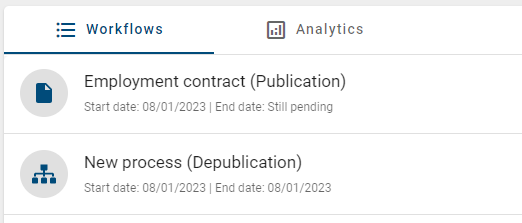
To view more information about a workflow, select an entry from the list of release workflows. You will then be redirected to the audit trail of the selected workflow. The audit trail provides detailed information about the workflow’s progress and allows you, via the Options panel in the right sidebar, to open the corresponding diagram or catalog object and download the archive. Users with the Administrator or Editor role can also delegate a pending workflow task directly from the audit trail or manually abort the workflow.
Workflows
Search and filter workflows
How can I search for workflows?
Every user can search for specific workflows in the list of available workflows. To do so, navigate to the Governance Cockpit menu item in the left menu bar. In the Filter panel in the right sidebar, you will find the Search workflows list input field. Enter your search term and start the search by pressing the Enter key or clicking the Search button. The search term can include the name of a diagram or catalog object, as well as the username or email address of an initiator or user who had or currently has a workflow task.
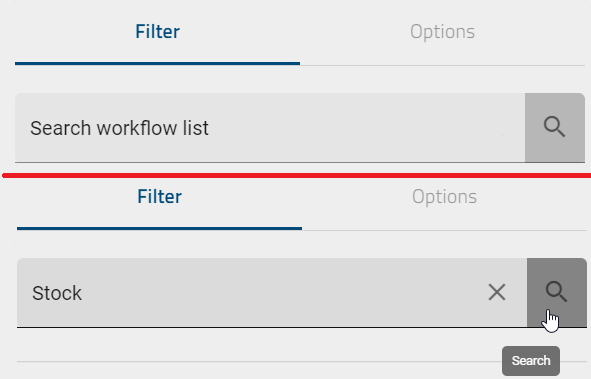
Note
Here you can find an overview of the available options when using search terms.
After starting the search, a workflow list filtered by your search term is displayed. Please note that the list may still be restricted based on your user role or access restrictions. If no results match your search term, a corresponding message is shown.
If you want to reset your search, click the Reset search and filters button. The full workflow list will then be displayed again.

Hint
In addition to the search term, you can also apply specific filters. Please note, however, that clicking the Reset search and filters button will also remove any filters you have applied.
How can I filter workflows?
Every user has the option to filter the workflow list to quickly locate the workflow they need. To do this, navigate to the Governance Cockpit menu item in the left menu bar. In the Filter panel in the right sidebar, you will find various options to filter the workflow list. Please note that the filtered list may still be restricted based on your user role or access restrictions. The available filters are explained below.
State: You can filter the list by the state of the workflows. By default, both open and closed workflows are displayed. A workflow is considered Open if it has not yet been completed. Workflows that have been finished or aborted are considered Closed. By selecting the corresponding option in the right sidebar, the current list is filtered according to the chosen criterion.
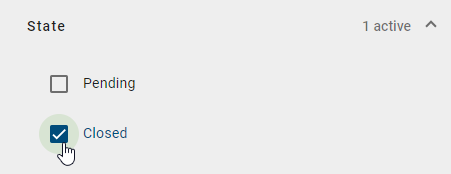
Period: With this filter, you can narrow down the time period by selecting a start and end date. You can either enter the start and/or end date directly into the input field or select the desired date using the calendar view. To open the calendar view, click the calendar icon on the right side of the regarding input field.
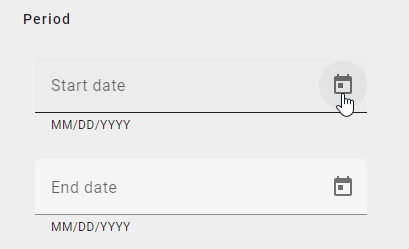
Next, select the desired date using the calendar. Clicking on a date will insert it into the corresponding input field.
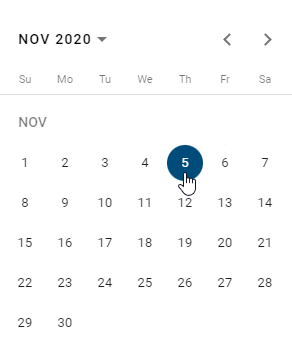
The workflow list will then be filtered automatically. The date is displayed in the format of your selected content language. If only the start date is set, all workflows that started after this date are shown. If only the end date is set, all workflows that ended before this date or are still pending are shown. If both start and end dates are set, all workflows that started and ended within this period are listed.
Type: You can filter workflows for both diagrams and catalog objects by the workflow types Publication, Depublication, Resubmission, and Update. You can select one or more types. Once you have made your selection, only the workflows of the chosen types are displayed.

Repository: This filter shows you the names of all repositories you have access to. If a repository does not have a value in your current content language, the alternative language is used if available. Once you select a repository, only workflows related to diagrams or catalog objects from this repository are displayed. You can also filter by multiple repositories simultaneously.
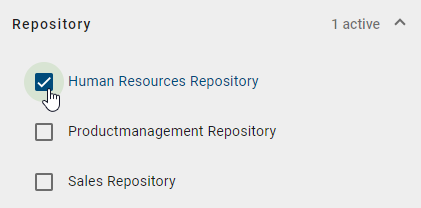
As soon as at least one filter is applied to a filter facet, the number of active filters is displayed next to the facet. This allows you to see at a glance how many filters are active, even if the facet is collapsed.

As an alternative to filtering, you can also search directly for individual workflows. You can further narrow down your search by applying filters.
Audit trail
What information does the audit trail of a workflow provide?
The audit trail of a workflow provides a chronological record of all activities within the process, allowing you to trace who performed which action, when, and why. To view the audit trail of a workflow, navigate to the Governance Cockpit menu item in the left menu bar. Click on a workflow in the workflow list to open the audit trail for the selected workflow.
The audit trail displays both the start date and the individual steps of the workflow in chronological order, arranged from bottom to top. The first step is always the initiation of the workflow.
On the left side of each step, a chip displays the initials of the user who performed that step. Hovering your mouse over the chip reveals the full name of the user. If the workflow is a resubmission, the chip shows an Android symbol. Hovering over it displays the name Resubmission assistant. To the right of each step, the associated comment is also shown if one was provided.

Hint
If a participating user is marked as inactive in the Governance Cockpit, that user has been deleted. The name of a deleted user is only marked as inactive if they were deleted starting from version 7.9.0. Please note that users deleted before version 7.9.0 cannot be displayed.
For change workflows carried out as part of the bulk update of diagrams in the Preview or Publication stages, you can view all update information in the audit trail. If some diagrams could not be updated successfully, the reason will be shown in the diagram(s) not updated section.
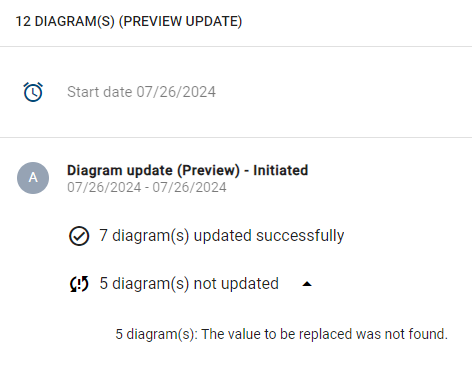
In addition to the information provided in the audit trail of a workflow, the Options panel is available in the right sidebar. Further details can be found here.
To return to the workflow list, click the Go to Workflow option in the header next to the workflow name, or click the back arrow in the header.

What options do I have in the audit trail of a workflow?
To view the options in the audit trail of a workflow, first navigate to the Governance Cockpit menu item in the left menu bar. Click on a workflow in the workflow list. The audit trail of the selected workflow will then open. After that, the Options panel will be available in the right sidebar.
In the Options panel, three options are displayed, depending on your user role or the workflow type. First, you can open the relevant object (diagram or catalog item) directly. To do this, select the Open diagram or Open catalog item option.

The system will then always display the relevant object in the appropriate stage. The stage depends on the workflow type. Please note that access to the object may be restricted depending on your user role or access restrictions.
For completed publications as well as when accessed from an audit trail, a resubmission, or a depublication, you are taken to the relevant object in the Publication stage of the corresponding repository.
For pending publications or when a reviewer has requested a revision of a diagram, you are taken to the relevant object in the Preview stage of the corresponding repository.
Note
If BIC EAM has been purchased and activated, workflows of context diagrams can also be displayed. Depending on whether the context diagram was created via catalog modeling or diagram modeling, you will be redirected to the respective catalog item or diagram view.
In addition, two further options are displayed in the Options panel of the right sidebar, depending on your user role or the workflow type. Explanations of these options are linked below:
For change workflows carried out as part of the bulk update, you can download the log file (JSON). In this case, the Options panel will only display the Download log file (JSON) option.

Delegate and abort workflows
How can I delegate a workflow task?
As a user with the Administrator or Editor role, you can delegate pending workflow tasks to other users. To do this, go to the Governance Cockpit menu item in the left menu bar and open a workflow with a pending end date from the workflow list. The audit trail of the selected workflow will then open. The pending task is listed at the top. By clicking the Delegate task button on the right side of the task, you can delegate it to another user.
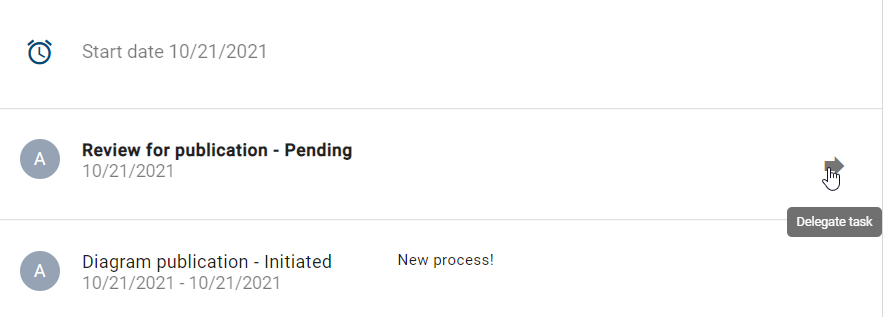
When you click the Delegate task button, a dialog opens where you can enter the name of the desired user and select them from the suggestion list. Clicking the Delegate button assigns the task to the selected user, and it appears in their task list, while it is removed from the previous task owner’s list. To cancel the delegation, click the Cancel button.
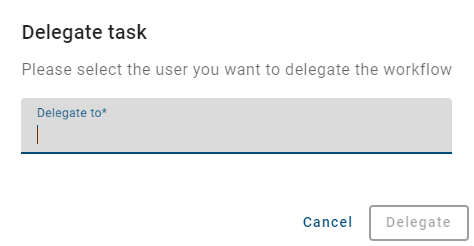
Hint
Please note that you cannot delegate a task to users with the Reader role, as this role lacks the necessary permissions to work on a task.
Once you have delegated the task to another user, this action is documented in the audit trail of the associated workflow and is visible to all users.

Note
If a workflow is closed (i.e., completed or aborted), tasks can no longer be delegated.
How can I abort a workflow?
Users with the Administrator or Editor role, as well as workflow initiators, have the option to abort workflows before completion. This option is only available while a workflow task is still pending. To abort a workflow, go to the Governance Cockpit menu item in the left menu bar and open a workflow with a pending end date from the workflow list. The audit trail of the selected workflow will then open.
In the right sidebar, in the Options panel, the Abort workflow option is available. If you have a different user role or the workflow has already been completed, the option will appear grayed out.

When you click this option, a security prompt will appear to confirm the termination of the workflow. Click the Abort workflow button again to permanently abort the workflow. This action cannot be undone.

The workflow is then aborted, and the usual process of publication or depublication is stopped. No further users will receive a task. The initiator and any involved users are informed about the termination by email. The version of the diagram or catalog item remains in the stage it was in at the time of the abortion. For example, after aborting a publication, the Preview stage will still contain the diagram that was originally intended for publication.
Export and download workflows
How can I export all workflow tasks as an Excel file?
Users with the Administrator or Editor role can export all workflow tasks as an Excel file. The workflow tasks to be exported can first be narrowed down by applying filters in the Filter panel.To do this, go to the Governance Cockpit menu item in the left menu bar and switch to the Options panel in the right sidebar while in the Workflows tab. There, you will find the Export workflow tasks option, which can be executed by clicking the Export to Excel button.

After clicking the button, a notification will appear at the bottom right of the screen indicating that the Excel file is being generated. Once the generation is complete, another notification appears with a link to download the export. When you click the link, the Excel file will be downloaded.
Alternatively, a new button Download Excel file will appear to the right of the Export workflow tasks option, allowing you to download the Excel file at a later time as well.

After downloading the Excel file, the following data is provided in the “workflow_export” sheet:
Workflow information
Workflow ID
Workflow type (Publication, Depublication or Resubmission; either for an object or a diagram)
Name of the related entity and its type
Start date of the workflow
End date of the workflow
Task information
Task ID
Task type ((De-)Publication (initiation), approve publication or removal, review for publication or resubmission)
Task owner (email address for users, user group name for groups)
Date of task assignment
Date of task completion (empty for open tasks)
Task status
Hint
The dates included in your exports (e.g., “Valid from,” “Valid to,” “Created date,” and similar) are converted into the time zone of the currently active user. This ensures that date information is always displayed in accordance with the user’s current time zone.
Hint
If a participating user is marked as inactive in the Governance Cockpit, the user was deleted. The name of a deleted user is only marked as inactive if the deletion occurred starting with version 7.9.0. Please note that users deleted before version 7.9.0 cannot be displayed.
How can I download the archive of a workflow?
Every user has the option to download the archive of a workflow, provided that all required conditions are met. These conditions include:
The workflow must be of the type Depublication and must have been completed with approval, and
there must be no active workflow for the respective object (diagram or catalog item).
To download the archive of a workflow, click on the Governance Cockpit menu item in the left menu bar and open a completed workflow of type Depublication from the workflow list. The audit trail of the selected workflow will then open.
In the right sidebar, in the Options panel, the Download archive option will be displayed. By clicking this option, the archive will be downloaded as a .zip file. If the option is shown as grayed out, not all required conditions are fulfilled.

Hint
Only the archive of the most recent depublication of a workflow is available. For example, if a workflow has been depublished multiple times, you will only have access to the archive of the last depublication.
Analytics
What information is displayed in the “Analytics” view?
Users with the Administrator or Editor role can gain a comprehensive overview of unpublished diagrams and catalog items, upcoming resubmissions, and completed publications of a specific repository. To access this view, click on the Governance Cockpit menu item in the left menu bar and switch to the Analytics tab in the header of the main area.

In this view, the diagrams and catalog items contained in the current repository are summarized in various bar charts. To display data from a different repository, use the Filter panel in the right sidebar to select the desired repository. Only repositories for which you have access and no restrictions have been defined will be displayed.
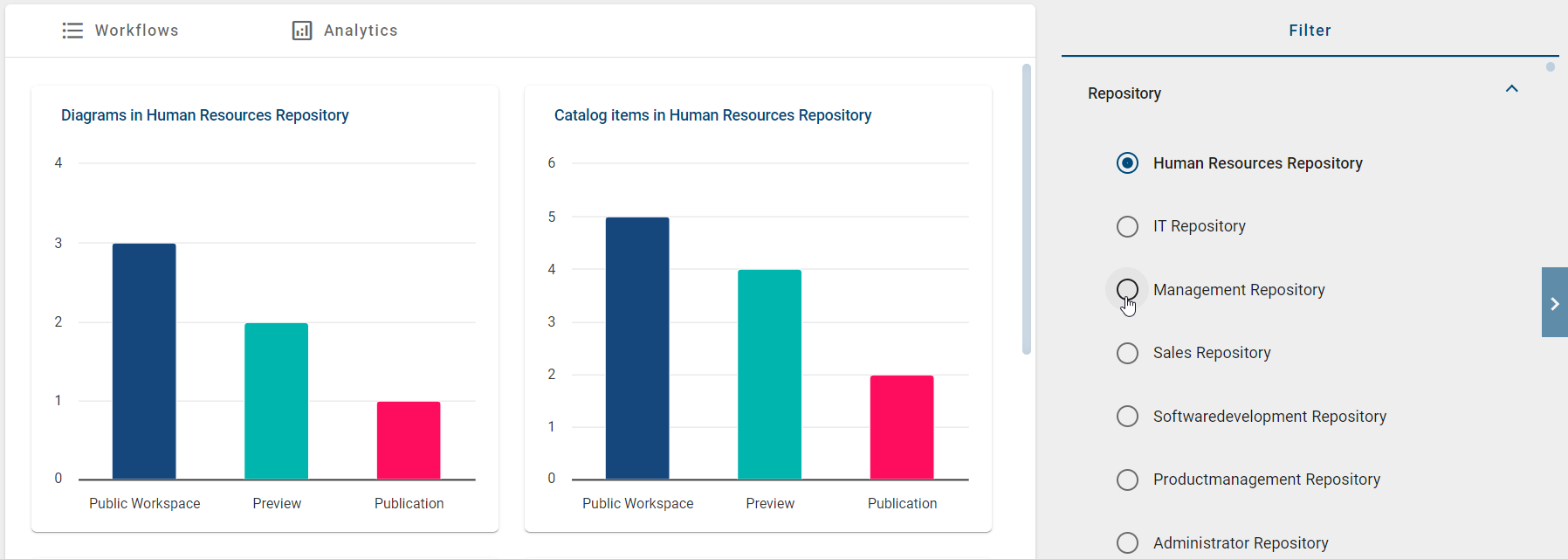
The Analytics tab provides the following views, which are explained in more detail below:
Diagrams (catalog items) in the selected repository
Upcoming diagram (catalog item) resubmissions in the selected repository
Finished publications of diagrams (catalog items) in the selected repository
Diagrams (catalog items) in the selected repository:
These bar charts compare the number of diagrams (catalog items) in the three stages Public Workspace, Preview, and Publication. If you hover over a bar with the mouse, the number of diagrams (catalog items) in the corresponding stage is displayed.
This view allows you to immediately see how many diagrams (catalog items) are currently modeled but not yet available to all users in the published version. If the number of diagrams (catalog items) in the Preview stage is significantly higher than in the Publication stage, this indicates that many release workflows are still open and need to be processed.
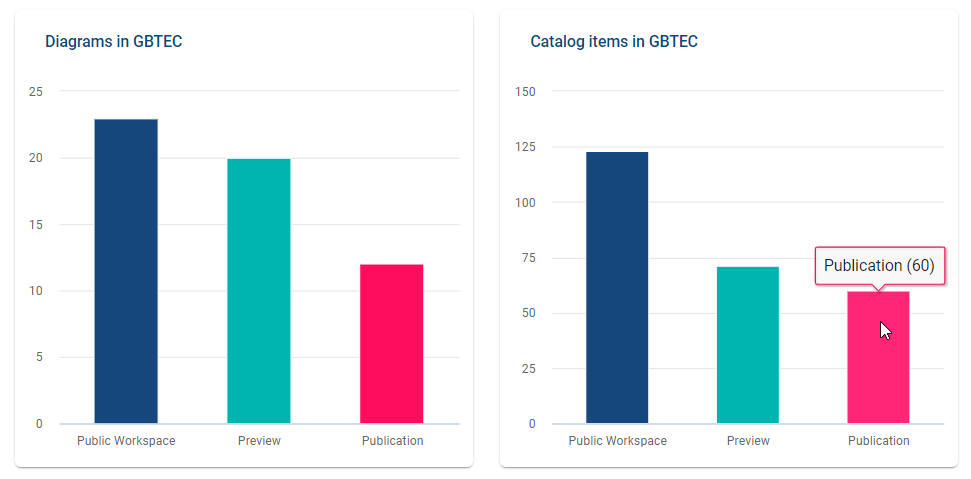
Note
The number of catalog items displayed in this bar chart for the Publication stage (red bar) may differ from the number shown in the catalog list. This happens if the visibility of certain catalog object types has been disabled in the Administration. Catalog items of these types no longer appear in the list but are still counted as published catalog items in the bar chart. For more information on catalog item visibility, see this section of the documentation.
If you click on a bar representing a stage for diagrams (catalog items), you will be redirected to the Dashboard tab of the “Diagrams” menu item or the “Catalog” menu item and placed in the selected stage. Navigation occurs within the currently selected repository. An explanation of these views can be found in the linked sections.
Upcoming diagram (catalog item) resubmissions in the selected repository:
These bar charts display the number of upcoming resubmissions of all diagrams (catalog items) in the selected repository for the next year. The timeline starts with the current month and year. Each bar represents all diagrams (catalog items) whose validity period expires in the respective month. This provides an early estimate of the workload for quality assurance of your processes. Hovering over a bar with the mouse shows the exact number of upcoming resubmissions for that month.

Finished publications of diagrams (catalog items) in the selected repository:
To provide an overview of the finished publications in the selected repository, these bar charts summarize the published diagrams (catalog items). For each month of the past year, a bar shows the number of diagrams (catalog items) for which a release workflow was completed in that month. The last bar represents the number of already published diagrams (catalog items) in the current month. If you hover over a bar with the mouse, the exact number of completed publications for the selected month is displayed.
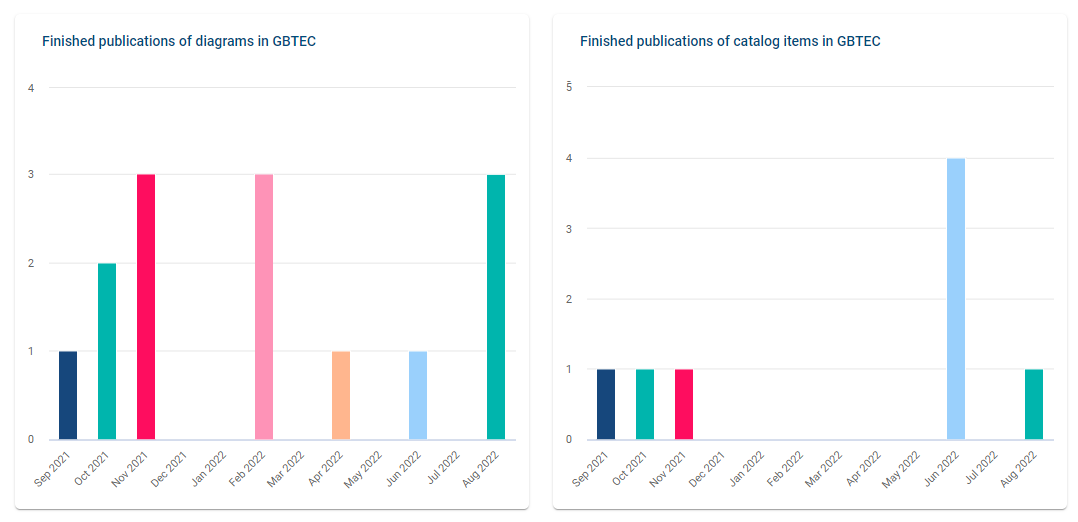
Hint
Please note that upcoming resubmissions and finished publications of diagrams and catalog items are based on validity dates. Unlike in the workflow list, the data refers to the Valid to/Valid from date and not the Start and End date.
Roadmap
What information is displayed in the “Roadmap” view?
Users with the Administrator or Editor role can gain a comprehensive overview of the validity periods of published processes in the current repository. To do this, click on the Governance Cockpit menu item in the left menu bar and switch to the Roadmap tab in the header of the main area.

To display an overview of the validity periods of published processes, the current repository must contain at least one published diagram with a valid validity period. Next, you need to select at least one filter in the Settings panel in the right sidebar. Once a filter has been selected, the roadmap will appear in the main area.
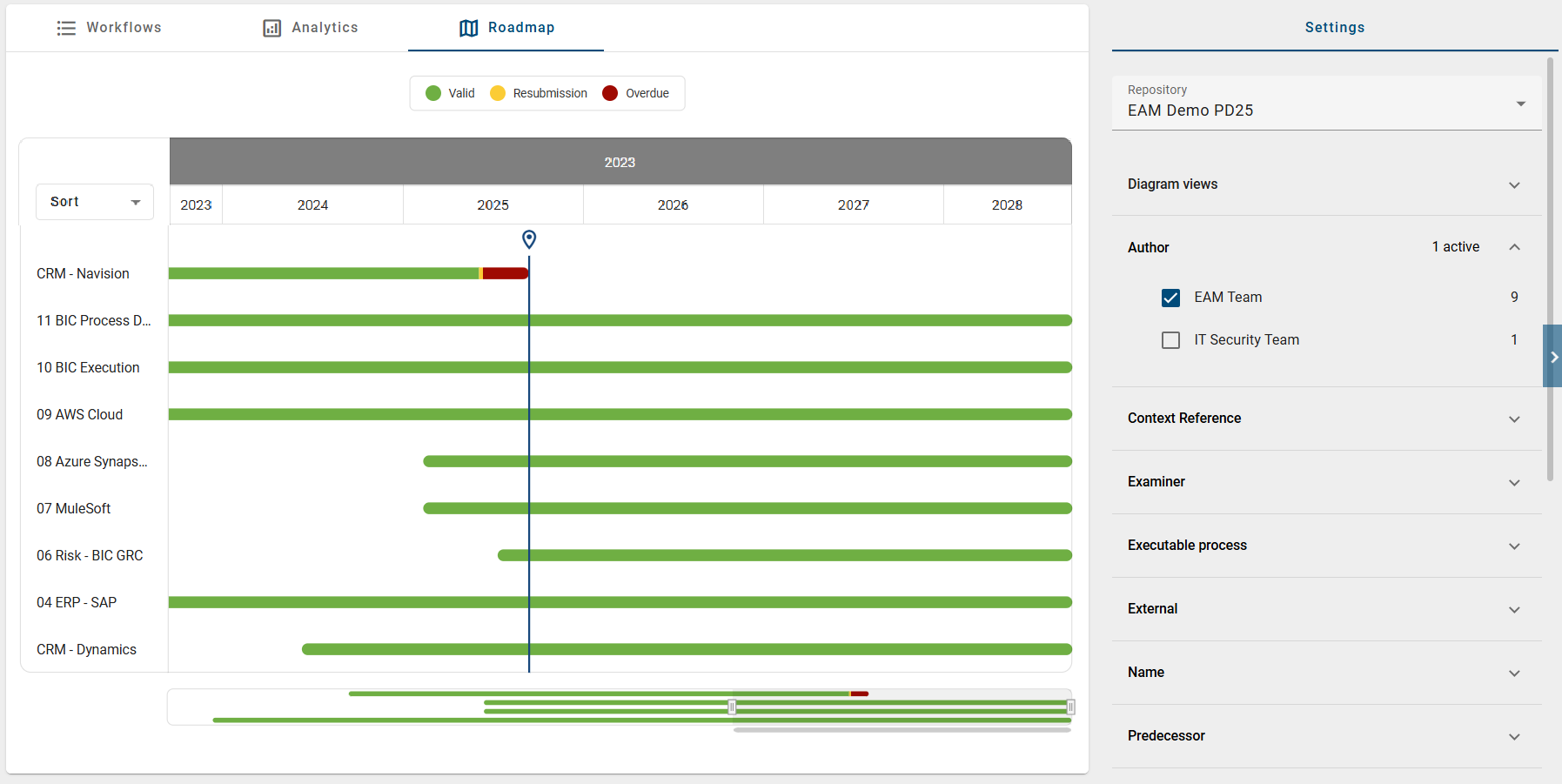
On the left side of the roadmap, the names of the published diagrams are listed alphabetically according to the current content language of the selected repository and in line with the selected filter criteria. If a diagram access restriction has been defined for you, these diagrams will not be displayed in the roadmap. Below the roadmap is a navigator whose width can be adjusted. This allows you to navigate through the entire roadmap and customize the view.
Above the roadmap is a legend representing the phases in the roadmap. By clicking on a phase in the legend, you can show or hide it in the roadmap. Hidden phases are grayed out in the roadmap. In addition, the phases are distinguished by color:
Valid (green): The period during which the published diagram is valid.
Resubmission (yellow): The period shortly before the validity date expires. This period corresponds to the configured resubmission reminder in the Administration and can be adjusted at any time by the administrator.
Overdue (red): The period during which the published diagram is no longer valid.

For each diagram, the roadmap shows the period with start and end of validity. If no validity end date is defined, the roadmap displays a fictitious end date of +3 years to indicate that the diagram remains valid for a longer period. For more detailed information about the validity period, hover your mouse over the respective phase.

Tip
For a meaningful representation of the roadmap, we recommend defining the validity periods of diagrams during diagram modeling.
Using this roadmap, you can present the validity periods of your current repository more clearly, identify overlaps or gaps, and respond early to expiring or upcoming processes.
Note
Please note that the roadmap can display a maximum of 500 published processes.
How can I sort diagrams by name or validity period?
Users with the user role Administrator or Editor can sort the diagrams displayed in the roadmap by name or by validity period. To do this, click on the menu item Governance Cockpit in the left menu bar and switch to the Roadmap tab in the header of the main area.
To display a roadmap of the validity periods of published processes, the current repository must contain at least one published diagram with a valid validity period. Next, you need to select at least one filter in the Settings panel in the right sidebar. Once a filter has been selected, the roadmap will appear in the main area.
On the left side of the roadmap, the published diagrams are listed alphabetically according to the current content language of the selected repository, taking into account the activated filter criteria. To make the display clearer, you can determine the order of the displayed diagrams yourself. To do this, navigate to the left side and click on the Sort button.

Here you can select whether the diagrams are to be sorted alphabetically or according to their validity period. When sorting alphabetically, you can choose between an order from A to Z or from Z to A. When sorting by time, you have the option of sorting the diagrams according to the Valid from or Valid to date, either from oldest to newest or from newest to oldest.
As soon as you select a sorting option, the list of diagrams displayed is automatically adjusted. Diagrams without a Valid to date are taken into account by an automatically assigned date so that they are sorted correctly.

